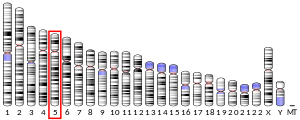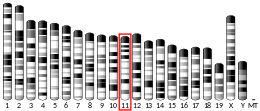TNIP1
TNFAIP3-interacting protein 1 is a protein that in humans is encoded by the TNIP1 gene.[5][6][7]
Association with autoimmune diseases
Genetic variations within the region of the TNIP1 gene have been shown to have association with several autoimmune diseases:
- Systemic Sclerosis;[8]
- Psoriasis;[9]
- Psoriatic arthritis;[10]
- Systemic Lupus Erythematosus[11][12]
Interactions
TNIP1 has been shown to interact with TNFAIP3[13] and MAPK1.[14]
gollark: I mean, it makes sens from an internal consistency perspective, but no.
gollark: "If you want to murder people, do; if you don't, don't" doesn't make sense.
gollark: Well, we disallow murder and stuff because of consensuses that they're bad.
gollark: Ah, but the person doesn't exist at the time. They do exist if you create them, and thus have rights and access to time machines.
gollark: A good fraction of them were part of HeavOS initially.
References
- GRCh38: Ensembl release 89: ENSG00000145901 - Ensembl, May 2017
- GRCm38: Ensembl release 89: ENSMUSG00000020400 - Ensembl, May 2017
- "Human PubMed Reference:". National Center for Biotechnology Information, U.S. National Library of Medicine.
- "Mouse PubMed Reference:". National Center for Biotechnology Information, U.S. National Library of Medicine.
- Fukushi M, Dixon J, Kimura T, Tsurutani N, Dixon MJ, Yamamoto N (Jan 1999). "Identification and cloning of a novel cellular protein Naf1, Nef-associated factor 1, that increases cell surface CD4 expression". FEBS Letters. 442 (1): 83–8. doi:10.1016/S0014-5793(98)01631-7. PMID 9923610.
- Gupta K, Ott D, Hope TJ, Siliciano RF, Boeke JD (Dec 2000). "A human nuclear shuttling protein that interacts with human immunodeficiency virus type 1 matrix is packaged into virions". Journal of Virology. 74 (24): 11811–24. doi:10.1128/JVI.74.24.11811-11824.2000. PMC 112464. PMID 11090181.
- "Entrez Gene: TNIP1 TNFAIP3 interacting protein 1".
- Allanore Y, Saad M, Dieudé P, Avouac J, Distler JH, Amouyel P, et al. (Jul 2011). "Genome-wide scan identifies TNIP1, PSORS1C1, and RHOB as novel risk loci for systemic sclerosis". PLoS Genetics. 7 (7): e1002091. doi:10.1371/journal.pgen.1002091. PMC 3131285. PMID 21750679.
- Nair RP, Duffin KC, Helms C, Ding J, Stuart PE, Goldgar D, et al. (Feb 2009). "Genome-wide scan reveals association of psoriasis with IL-23 and NF-kappaB pathways". Nature Genetics. 41 (2): 199–204. doi:10.1038/ng.311. PMC 2745122. PMID 19169254.
- Bowes J, Orozco G, Flynn E, Ho P, Brier R, Marzo-Ortega H, et al. (Sep 2011). "Confirmation of TNIP1 and IL23A as susceptibility loci for psoriatic arthritis". Annals of the Rheumatic Diseases. 70 (9): 1641–4. doi:10.1136/ard.2011.150102. PMC 3147229. PMID 21623003.
- Gateva V, Sandling JK, Hom G, Taylor KE, Chung SA, Sun X, et al. (Nov 2009). "A large-scale replication study identifies TNIP1, PRDM1, JAZF1, UHRF1BP1 and IL10 as risk loci for systemic lupus erythematosus". Nature Genetics. 41 (11): 1228–33. doi:10.1038/ng.468. PMC 2925843. PMID 19838195.
- Han JW, Zheng HF, Cui Y, Sun LD, Ye DQ, Hu Z, et al. (Nov 2009). "Genome-wide association study in a Chinese Han population identifies nine new susceptibility loci for systemic lupus erythematosus". Nature Genetics. 41 (11): 1234–7. doi:10.1038/ng.472. PMID 19838193.
- Heyninck K, De Valck D, Vanden Berghe W, Van Criekinge W, Contreras R, Fiers W, Haegeman G, Beyaert R (Jun 1999). "The zinc finger protein A20 inhibits TNF-induced NF-kappaB-dependent gene expression by interfering with an RIP- or TRAF2-mediated transactivation signal and directly binds to a novel NF-kappaB-inhibiting protein ABIN". The Journal of Cell Biology. 145 (7): 1471–82. doi:10.1083/jcb.145.7.1471. PMC 2133159. PMID 10385526.
- Zhang S, Fukushi M, Hashimoto S, Gao C, Huang L, Fukuyo Y, Nakajima T, Amagasa T, Enomoto S, Koike K, Miura O, Yamamoto N, Tsuchida N (Sep 2002). "A new ERK2 binding protein, Naf1, attenuates the EGF/ERK2 nuclear signaling". Biochemical and Biophysical Research Communications. 297 (1): 17–23. doi:10.1016/S0006-291X(02)02086-7. PMID 12220502.
Further reading
- Nakajima D, Okazaki N, Yamakawa H, Kikuno R, Ohara O, Nagase T (Jun 2002). "Construction of expression-ready cDNA clones for KIAA genes: manual curation of 330 KIAA cDNA clones". DNA Research. 9 (3): 99–106. CiteSeerX 10.1.1.500.923. doi:10.1093/dnares/9.3.99. PMID 12168954.
- Nagase T, Miyajima N, Tanaka A, Sazuka T, Seki N, Sato S, Tabata S, Ishikawa K, Kawarabayasi Y, Kotani H (1995). "Prediction of the coding sequences of unidentified human genes. III. The coding sequences of 40 new genes (KIAA0081-KIAA0120) deduced by analysis of cDNA clones from human cell line KG-1". DNA Research. 2 (1): 37–43. doi:10.1093/dnares/2.1.37. PMID 7788527.
- Loftus SK, Dixon J, Koprivnikar K, Dixon MJ, Wasmuth JJ (Jan 1996). "Transcriptional map of the Treacher Collins candidate gene region". Genome Research. 6 (1): 26–34. doi:10.1101/gr.6.1.26. PMID 8681136.
- Jäkel S, Görlich D (Aug 1998). "Importin beta, transportin, RanBP5 and RanBP7 mediate nuclear import of ribosomal proteins in mammalian cells". The EMBO Journal. 17 (15): 4491–502. doi:10.1093/emboj/17.15.4491. PMC 1170780. PMID 9687515.
- Heyninck K, De Valck D, Vanden Berghe W, Van Criekinge W, Contreras R, Fiers W, Haegeman G, Beyaert R (Jun 1999). "The zinc finger protein A20 inhibits TNF-induced NF-kappaB-dependent gene expression by interfering with an RIP- or TRAF2-mediated transactivation signal and directly binds to a novel NF-kappaB-inhibiting protein ABIN". The Journal of Cell Biology. 145 (7): 1471–82. doi:10.1083/jcb.145.7.1471. PMC 2133159. PMID 10385526.
- Zhang S, Fukushi M, Hashimoto S, Gao C, Huang L, Fukuyo Y, Nakajima T, Amagasa T, Enomoto S, Koike K, Miura O, Yamamoto N, Tsuchida N (Sep 2002). "A new ERK2 binding protein, Naf1, attenuates the EGF/ERK2 nuclear signaling". Biochemical and Biophysical Research Communications. 297 (1): 17–23. doi:10.1016/S0006-291X(02)02086-7. PMID 12220502.
- Leonard D, Ajuh P, Lamond AI, Legerski RJ (Sep 2003). "hLodestar/HuF2 interacts with CDC5L and is involved in pre-mRNA splicing". Biochemical and Biophysical Research Communications. 308 (4): 793–801. CiteSeerX 10.1.1.539.8359. doi:10.1016/S0006-291X(03)01486-4. PMID 12927788.
- Gallagher J, Howlin J, McCarthy C, Murphy EP, Bresnihan B, FitzGerald O, Godson C, Brady HR, Martin F (Sep 2003). "Identification of Naf1/ABIN-1 among TNF-alpha-induced expressed genes in human synoviocytes using oligonucleotide microarrays". FEBS Letters. 551 (1–3): 8–12. doi:10.1016/S0014-5793(03)00823-8. PMID 12965196.
- Favre M, Butticaz C, Stevenson B, Jongeneel CV, Telenti A (Oct 2003). "High frequency of alternative splicing of human genes participating in the HIV-1 life cycle: a model using TSG101, betaTrCP, PPIA, INI1, NAF1, and PML". Journal of Acquired Immune Deficiency Syndromes. 34 (2): 127–33. doi:10.1097/00126334-200310010-00002. PMID 14526201.
- Bouwmeester T, Bauch A, Ruffner H, Angrand PO, Bergamini G, Croughton K, Cruciat C, Eberhard D, Gagneur J, Ghidelli S, Hopf C, Huhse B, Mangano R, Michon AM, Schirle M, Schlegl J, Schwab M, Stein MA, Bauer A, Casari G, Drewes G, Gavin AC, Jackson DB, Joberty G, Neubauer G, Rick J, Kuster B, Superti-Furga G (Feb 2004). "A physical and functional map of the human TNF-alpha/NF-kappa B signal transduction pathway". Nature Cell Biology. 6 (2): 97–105. doi:10.1038/ncb1086. PMID 14743216.
- Colland F, Jacq X, Trouplin V, Mougin C, Groizeleau C, Hamburger A, Meil A, Wojcik J, Legrain P, Gauthier JM (Jul 2004). "Functional proteomics mapping of a human signaling pathway". Genome Research. 14 (7): 1324–32. doi:10.1101/gr.2334104. PMC 442148. PMID 15231748.
- Suzuki Y, Yamashita R, Shirota M, Sakakibara Y, Chiba J, Mizushima-Sugano J, Nakai K, Sugano S (Sep 2004). "Sequence comparison of human and mouse genes reveals a homologous block structure in the promoter regions". Genome Research. 14 (9): 1711–8. doi:10.1101/gr.2435604. PMC 515316. PMID 15342556.
- Hoareau-Aveilla C, Bonoli M, Caizergues-Ferrer M, Henry Y (May 2006). "hNaf1 is required for accumulation of human box H/ACA snoRNPs, scaRNPs, and telomerase". RNA. 12 (5): 832–40. doi:10.1261/rna.2344106. PMC 1440901. PMID 16601202.
External links
- TNIP1 human gene location in the UCSC Genome Browser.
- TNIP1 human gene details in the UCSC Genome Browser.
This article is issued from Wikipedia. The text is licensed under Creative Commons - Attribution - Sharealike. Additional terms may apply for the media files.




